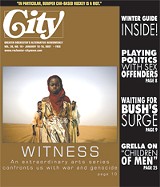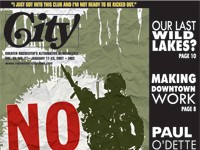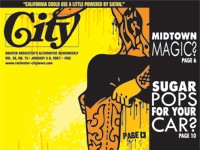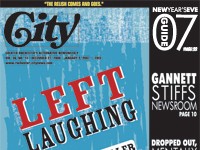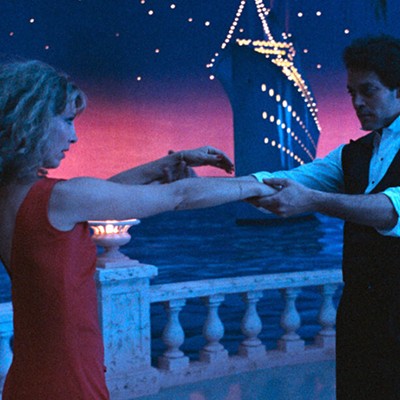[
{
"name": "500x250 Ad",
"insertPoint": "5",
"component": "15667920",
"parentWrapperClass": "",
"requiredCountToDisplay": "1"
}
]
We see the pictures every night on newscasts: brief glimpses of the horror occurring in foreign countries. A few more images, lost in the blur of celebrity gossip and political squabbling. It's easy in the United States to go about life unaffected by the war and genocide taking place in other parts of the world.
The George Eastman House and several other cultural and educational institutions want to shake us out of our complacency.
"Witness: Know War/Know Genocide," which begins on January 20, is an extraordinary collection of exhibitions, programs, and activities. It's among the most ambitious collaborative arts efforts ever undertaken in Rochester, and it's also unusual in its call to action regarding the genocide in Darfur.
Over the next several months, the Eastman House will mount four exhibitions dealing with war and genocide. The shows range from a historical perspective on images of war to deeply personal responses to it. While exhibitions form the core of "Witness," there is much more.
Rochester's Interfaith Darfur Coalition will lead a candlelight vigil later this month. In March, Geva Theatre will mount a play about Iraqi women during and after the regime of Saddam Hussein. Nazareth College will present lectures, plays, and an exhibition related to war and genocide. Other programs being planned involve Afrakuumba Dance, BOA Editions, the Memorial Art Gallery, and other organizations.
There are two reasons the Eastman House is at the center of this effort, says Alison Nordstrom, the museum's curator of photographs,
"We're at war," says Nordstrom. "It's good for us to think about that. I'm struck by the difference between what it's like on the home front in 2007 and what it was like for our parents and grandparents in 1943. The whole country was mobilized. We're at war, but what it looks like is a few column inches in the newspaper and a few pictures on the evening news."
"In the field of photography," adds Nordstrom, "I'm interested in how the representation of war has both changed and stayed the same since we first had the technical capability of recording it."
Standing among her selections for "Know War," the exhibition that will line the Potter Peristyle later this month, Nordstrom discusses the different ways war has been portrayed in more than 150 years of war photography. The Eastman House is one of the few museums in the world housing images from the first war ever photographed (the Crimean War) to the most recent pictures from Iraq and Afghanistan.
Among the early photographs are iconic Civil War images of the battlefield dead, images that remind Nordstrom of a sad irony.
"When Oliver Wendell Holmes saw Alexander's Civil War photographs in 1865," says Nordstrom, "he said something along the lines of:'This is great; now that people have seen what war looks like, we won't do it anymore.'"
Although some ofthe more graphic images prompted staff discussions at the Eastman House, none of the photographs Nordstrom selected for the show were excluded.
One picture that is not easy to look at shows the immediate aftermath of a suicide bombing in Afghanistan. The bomber is lying dead amid the rubble in this unflinching photograph taken last year by Louie Palu. Another disturbing image is a 1951 Korean War photograph by Max Desfor showing hands that were tied, sticking up out of the snow after an execution.
"We asked, Are we really going to put this on the wall?" says Nordstrom. "We said, yes." She doesn't want people to turn away, she says,"but there aren't many nice pictures of war."
And, she points out, images don't have to be graphic to be upsetting.
A photograph Nordstrom personally found difficult was taken by Margaret Bourke-White after she entered Berlin with the conquering American army in 1945. Some high-ranking Nazi officials had chosen to kill themselves and their families rather than surrender. The photograph shows two young children whose parents had killed them.
Another image, by Ernst Haas, depicts an Austrian woman showing a picture of a soldier to a returning prisoner of war in 1945. She is obviously the mother of a soldier she hopes was taken prisoner and not killed. The image is universal, containing the same sense of desperation as images of people holding photos of loved ones in the aftermath of September 11.
There are pictures in the show that palpably capture the frantic pace of war. The blur of action in Raymond Depardon's photograph of a militiaman firing his weapon in Beirut in 1978 draws the viewer into the battle. One can only imagine the danger Depardon put himself in to get it.
Nordstrom has often talked to war photographers about the risks associated with their jobs.
"I'm amazed at how many people genuinely feel an obligation to go and bring the story back," she says. "There is the sense of mission."
A photographer known for his passionate point of view --- and who didn't make it back from an assignment --- is the subject of another exhibition, "Reflections of the Heart: Photographs by David Seymour."
Seymour, known as Chim, founded the Magnum Photos agency. He was killed in 1956 while documenting the war in Suez.
"He was the first 'concerned photographer,'" says Nordstrom. "He had a strong point of view, and the camera was his weapon." The exhibition is not particularly about the action of war, says Nordstrom, but "what came after, before, and at the edges of war."
While many of Seymour's photographs are optimistic, providing a glimmer of rebirth after a war, there are also subtly disquieting images. One of the most powerful depicts a 1948 ballgame played by children in Italy who have been maimed by the war.
Looking at images from the Eastman House collection and the latest photographs from Darfur is, in many ways, a very strange experience.
We live in a time when a person can visit a foreign place --- even one where two sides are killing each other in a war --- and, without becoming part of what's going on, can witness it and bring back images for others to see without leaving their homes.
"It's almost like messengers from another planet --- another reality," says Nordstrom. "But we've always had interpreters of experience, and since 1839 people equipped with cameras have gone out to bring back visual information about places that, for one reason or another, we in our armchairs chose not to visit. The danger is that they look so real that we can make the mistake of thinking we've had a real experience."
The nature of reality as reflected in photographs is one of the key issues that may come to mind when confronted with images of war.
Perhaps the most unusual picture in "Know War" is a diptych by Rita Leistner, created in Beirut last summer.
On one side of the image a young, angelic-looking female stands on a terrace overlooking the city. On the other side, parts of the battered city can be seen through the shattered windows of a building. The two parts are merged seamlessly; in each the sky is the same deep gray. It could easily be mistaken for a single photograph.
Because Leistner combined the images to create a scene that did not actually exist, some viewers might consider this to be more art than photojournalism, but Nordstrom does not believe it's useful to make such a distinction.
"Robert Flaherty, the father of the documentary film, said, 'Sometimes to tell the truth you have to distort it.' What [Leistner] is telling us is the feeling of being in Beirut last summer and having your house destroyed. Photographers have always looked for ways to push the envelope."
Distinctions between art and photojournalism are constantly in flux, Nordstrom notes. Civil War photographs, once considered documents, are now considered works of art. The Metropolitan Museum of Art collects them.
Nordstrom walks over to Josef Koudelka's 1968 Prague Spring photograph, showing an unarmed young man confronting armed soldiers. She wonders if four decades later, the photograph has taken on a symbolic power that transcends the particular incident.
"So has this morphed into a work of art?" she asks. "Maybe."
Although photography is the medium most trusted to accurately reflect our world, many ethical issues about the medium have emerged in recent years.
The latest example occurred this past summer, when questions were raised over the manipulation of an image from the Israel-Hezbollah war. The digital photograph was enhanced, using Photoshop, to make it look like more smoke was pouring out of a building than actually was.
Photoshop is the latest tool, but even some Civil War photographs by Mathew Brady are known to have been manipulated. The photographer dragged bodies from one spot to another to create a more evocative tableau.
As a historian, Nordstrom knows that photographs have been manipulated since the beginning. The integrity of the witness and the publication, she says, are the crucial elements in trusting war photography.
Even though it is easier to manipulate images with digital photography, Nordstrom says we're closer to accuracy than we've ever been.
"When Robert Capa made his photographs, he never saw them," she says. "The film, unexposed, went back to the lab, by carrier pigeon sometimes, and would be printed there. An editor would choose what looked true to him. Nowadays, you look at all of your photographs before sending them by satellite. Editing is being done on the spot, in the field, by the person who was there. And he or she is saying: Yes, that's the one that feels true to my experience."
Of course, the vast majority of journalistic photographs are not manipulated. But they still have a point of view. The photographer chooses which way to turn and what to shoot. And Nordstrom has seen incidents where the same photograph has been used by opposing sides to support different points of view.
"The slipperiness of photographs is that they look like truth," she says. "They're not. If we discover that they twisted the truth or were used by others to twist the truth, we feel much more betrayed."
Even if photographs are completely honest and are in the possession of news media, that doesn't mean the truth will emerge.
"Only in the last weeks of World War II did American newspapers show photographs of the American dead," says Nordstrom. "They would show the enemy dead, but the decision was made that showing Americans would be bad for morale. We still have lots of restrictions. We don't show flag-draped coffins coming off of airplanes. We don't show recognizable American dead. We do see images more graphic than in the past."
Some of the most disturbing images in recent memory have come from Darfur. Tribal militiamen called the Janjaweed have slaughtered hundreds of thousands of people and burned hundreds of villages. Rape, murder, and genocide are taking place right before the world's eyes.
When the subject is Darfur, it is difficult for a photographer not to have a point of view.
"A photographer who chooses to go to Darfur is already making a decision about where he or she will put energy," says Nordstrom. "They could be covering another story somewhere else. So that's a point of view and a sense of mission and witness affecting the decision."
"Darfur/Darfur" is an unusual example of a museum not simply showing the work of the past, but prompting viewers to think about the present and trying to effect change.
At the Eastman House, six screens will be used to show digital images documenting the events that have led to the deaths of more than 400,000 people. In addition to the photographs, several feature-length documentaries will be shown.
Images have had power for centuries, but we now live in a world of violent video games and graphic movies. Can too many horrifying images in our culture rob war photographs of the impact they once had?
"Images still have power," says Nordstrom. "They can even sometimes move people to action."
Photographs can have even more power when placed in an unexpected context," says Nordstrom. While we are used to seeing them on the evening news or on the front page of the New York Times, we don't expect to see them in a museum context.
"A framed photograph on a white museum wall still has the possibility to surprise and encourage hard looking," says Nordstrom. "The dialog of two people standing in front of an object in a museum is different than two people watching television."
But some critics have argued that placing documentary photographs in a frame on a museum wall aestheticizes the horror.
Certainly some of the images of war or its aftermath in the Eastman House exhibitions are strangely beautiful. Yevgeny Khaldei's 1945 photograph of the fall of Berlin shows soldiers on a building almost becoming the statues mounted on the building's ledge. Many of the images of Darfur are strikingly beautiful.
"It is a museum collection, so aesthetics are a factor," says Nordstrom. It is aesthetics, she believes, that make these photographs into icons.
"Any photograph in a sense aestheticizes and removes what it smelled like and that sense of fear in your gut that the next bullet is going to be for you, but in some ways can make it more accessible," she says.
The fourth Eastman House show, "Ghosts in the Landscape," is unquestionably the most aesthetically oriented exhibition. It consists of photographs of Vietnam, whose war took place decades before the pictures were taken.
Former combat Marine Craig J. Barber made three trips back to Vietnam, where he had served 30 years earlier. His images, shot with a pinhole camera, are paired to form surreal landscapes of odd angles and improbable views.
This is a highly personal vision, a unique reflection of one man's experience with war. However, if the photographs appear to be beautiful, Nordstrom believes, they are deceptively so.
"These are haunted landscapes," she says. "You can almost hear him screaming."
The Eastman House has had some popular exhibitions over the last several years dealing with animals and Hollywood stars. It should be interesting to see whether filling the museum with images about war will be equally successful. Nordstrom hopes to do a lot more than bring people in.
"I hope it makes people think, and I hope it makes people do things," says Nordstrom. "Think of this museum as the museum of ideas."
"Part of our job is giving people the material of the past in a context that lets them sort it out and lets the past inform the present,"says Nordstrom. "I personally believe we have an obligation to do what we can with the resources that we have. It's possible that that work, in a very modest way, can spark someone to do something."
Aiding Darfur
Among the groups involved in "Witness" is the Rochester Interfaith Coalition for Darfur, which is urging state and federal officials to press harder for an end to the violence in western Sudan.
The coalition consists of the Jewish Community Federation, the Catholic Diocese, the Episcopal Diocese, area AmericanBaptistChurches, the Greater Rochester Community of Churches, Temple Beth El, FirstUniversalistChurch, and about a dozen other churches and charities.
Coalition members have launched letter-writing campaigns to the US State Department. They want the United Nations to send peacekeepers to Sudan to strengthen the African Union forces and secure landing space so more humanitarian aid can be delivered to refugee camps.
The coalition also asked former governor George Pataki to review the state's employee pension funds and divest from companies doing business with the Sudan government.
Information on upcoming events, joining the coalition, or obtaining form letters addressed to state and federal officials is available from Isobel Goldman at the Jewish Community Federation, 461-0490.
Darfur vigil
Candlelight vigil supporting the Darfuri people, sponsored by the Interfaith Darfur Coalition: 4:30 p.m. Sunday, January 21. Starts at AsburyFirstUnitedMethodistChurch, 1050 East Avenue, and ends at the Eastman House, with free viewing of the Darfur/Darfur exhibition.
Exhibitions
"Reflections from the Heart: Photographs by David Seymour," January 20-April 22. Works by the 20th-century photographer known as Chim, including coverage of the Spanish Civil War and World War II. Opening event: 6 p.m. Friday, January 26, with illustrated lecture by Seymour's nephew, Ben Schneiderman; Dryden Theatre, followed by reception. Admission $10 (free to members). Info: 271-3361.
"Know War," January 20-April 22. Photographs from the Eastman House collection depicting war from 1855 to the present, including works by Margaret Bourke-White, David Douglas Duncan, Joseph Koudelka, Susan Meiselas, and Louie Palu.
"Darfur/Darfur," January 20-April 22. Multimedia exhibition with works by some of the world's top photographers, clips from documentary films, and Sudanese-inspired music and words.
"Ghosts in the Landscape:Vietnam Revisited," February 17-May 6. Works by photographer Craig Barber, an ex-Marine who returned to Vietnam to photograph sights along his former military routes. Opening event: 2 p.m. Saturday, February 17, illustrated lecture by Barber; Dryden Theatre, followed by exhibition viewing and book signing. Included with museum admission (free to members). Info: 271-3361.
Photos on the genocide in Rwanda, March 3-March 31, NazarethArtsCenter lobby, NazarethCollege. Works by MichalRonnenSafdie. Opening event: 7:30 p.m. Saturday, March 3.
Additional lectures
"Hidden Children in the Holocaust," lecture by Holocaust survivor Maud Dhame: 7:30 p.m. Monday, February 12, NazarethCollege.
"On the Front Lines of Today's Wars," illustrated lecture by "Darfur/Darfur" photographer Ron Haviv: 6 p.m. Thursday, March 1, Dryden Theatre, followed by book signing. Included with museum admission (free to members). Info: 271-3361.
"Famous Names," on the mixed-media piece by Jaune Quick-to-See Smith, by Peter Jemison of Ganandogan, with discussion about the genocide of Native Americans: 7 p.m. Thursday, March 1, Memorial Art Gallery.
"Nature/Human Nature,"illustrated lecture by "Darfur/Darfur" photographer MichalRonnenSafdie: 6 p.m. Thursday, March 8, Dryden Theatre, followed by book signing. Included with museum admission (free to members). Info: 271-3361.
Photography lecture by Vietnam veteran Don Fox: 6:30 p.m. Thursday, April 12, CurtisTheatre, Eastman House. Included with museum admission (free to members). Info: 271-3361.
Theater
"Nine Parts of Desire," March 20-April 8, Geva Theatre's NextStage: the story of nine Iraqi women and their lives before, during, and after the rule of Saddam Hussein; for ages 17 and over.
"And Then They Came for Me," presented by Rochester Children's Theatre: March 4 and 6, NazarethArtsCenter.
"Cabaret," presented by Nazareth College Theatre Department: April 20-22 and April 27-29, Callahan Theater, NazarethArtsCenter.
Speaking of War Photography, Darfur Genocide
-
'Time is running out for Darfur'
Apr 19, 2006 - More »
Latest in Featured story
More by Ron Netsky
-

Album Review | 'Bizet: Carmen in Jazz'
Mar 26, 2024 -
'To Swing Is the Thing" by Mike Melito
Aug 10, 2023 - More »
